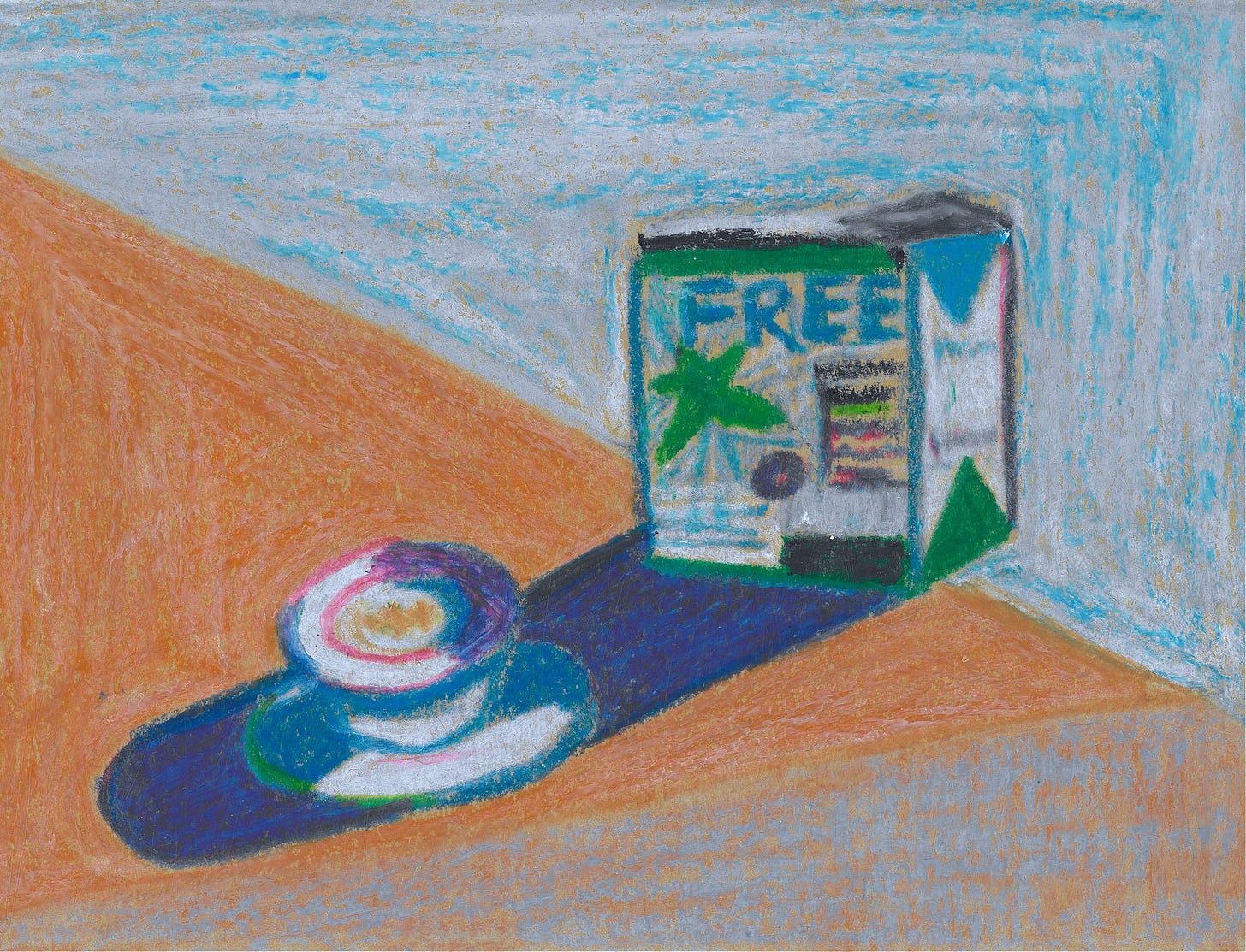Pies, loneliness, pies
Sugar and solitariness in Wayne Thiebaud's paintings, plus a writer community announcement
Hello old and new subscribers—welcome! If you like this newsletter, follow 💌shelfoffering on Instagram and please share with a friend or two.

I have to admit that my introduction to Wayne Thiebaud’s works happened only a few years before he passed away. But in that short span, I learnt a lot.
He was associated with pop art even though his work predates that movement. He was partial to impasto, painting on the surface very thickly, like Van Gogh before him (I guess you could say he caked it on). Exaggerated colours were his forte. Shadows were a little too well defined, which always made me wonder about his technique and constantly reflect on mine. I’m hopeless about three things when it comes to art (hands, shadows, and clouds), and I’ve only somewhat redeemed myself in one aspect (hands).
Thiebaud’s obsession with objects of mass culture is public knowledge, because it seemed to be all that he painted. It is useful to note that he used to work at cafes and stores with candy counters, which noticeably influenced his work. Also useful to note is that he was a Mormon, and that his language is very telling as he describes being “interested in foods [generally] which have been fooled with ritualistically, displays contrived and arranged in certain ways to tempt or seduce us”.
Ever since I read this quote, I’ve seen Thiebaud’s paintings in a different light. His pastries iced with a uniquely edible quality (which he achieved by mixing paint with Liquin) adorned with bright cherries on top; two yellow wedding cakes waiting to be picked up; sweets lined up under a counter; a vintage-y gumball machine waiting to be played with. Thick fluffy meringues piped on top of four solid pies; salt, pepper, sugar, honey, and ketchup encased in their containers (that Thiebaud described as ‘caged’); two ice cream cones plopped and smushed onto a table, one melting into a knowing smile. His oranges far more brilliant than the orangest American cheddars, slicks of pinks more classic than strawberry gum, stripes and dots adding more depth than askew shadows, reds and blues pairing more naturally than on a uniform, violets more ultra than UVs.
Thiebaud did paint more than the assembly line production of foods. There’s ‘Morning Freeway’, where the sky is an intense yellow—almost as if he’s mixed annatto into beige—and gently illuminates the buildings stacked like layer cakes. There’s ‘Virgina Landscape’ where the sloping shadows of the trees feel so much more distant than they are, like eerie knives preparing to confront the scene. His San Francisco cityscapes where everything, including the colour, is exaggerated (or maybe not, I’ve never been to SF), melding the abstract into reality. ‘Sunset Streets Study’, in particular, is a remedy to the colour-averse, and a jolt to the system to those suffering from the present-day malaise of beige. ‘Palm Tree and Cloud’ is cotton candy pink, hints of baby blue, and a striking buttercup yellow (Van Gogh is that you?).
But somehow, despite the exuberant colours, they’re all desolate.
‘Cold Cereal’ is haunting, ‘Hamburger’ with two sliced pickles lies untouched, ‘Strawberry Cone’ unmelting under the harsh sun of a sandy beach, ‘Two Seated Figures’ matched in their elegance but barely looking at each other, ‘Heavy Traffic’ unmoving and surreal, ‘Dress Shoes’ cast off after a long day. Every city view silent. Every portrait startlingly lonely. I’m not the first to notice that Thiebaud’s paintings have a solitary quality from what has been omitted and what has prevailed. Or that his juxtaposition of colours—even bright palettes need to be tempered slightly—with no context and neat shadows leave the viewer to fill in the gaps. There is as much isolation in his work of pies in a candy shop or soda pops lined on a counter, as there is silence in his paintings of landscapes.
I have no nostalgia for his city scenes. Sure, they evoke a sense of loneliness because they are essentially still and quiet, but the geometry of his pies and cakes, their symmetry and perspective, their vibrance and sensuousness, bring up a yearning and sentimentality that are different in my memory. Mine takes me back to when I was 13 attending maths tuition with a classmate. Afterwards we’d walk to a nearby bakery to share a plate of fries and cake, or get an ice cream float and watch people around us: couples trying to make the most of the evening before they had go their separate ways, groups of friends after college celebrating a birthday, city workers dropping by to take away egg puffs and vanilla cake, jobless uncles sitting and chatting and trying to find out more information about the couples…
I’m reminded here of Thiebaud’s “foods which have been fooled with ritualistically… and arranged in certain ways to tempt or seduce us”, perhaps because everyday objects taken out of context do seem lonely. They are lonely because they’re taken for granted. They’re dramatic and exaggerated, like objects of ritual often are. They’re Mondrianesque in their neat, foundational geometry. They’re Hopperesque if you gaze enough into the isolation of his works, the pink and purple halations underpinning a hidden joy in the ordinary that has the potential to become extraordinary.
Of course, his works are also situated in an era of American consumerism. But instead of highlighting the disdain in the affluence of iced cakes or meringue pies or mass consumption in a can of soup like Andy Warhol, Thiebaud’s depiction of patisserie seems to have come from a place of longing and melancholy. It’s what I love and enjoy about his works. They’re visually striking and vibrant, heralding delight and tenderness for simple everyday objects like rows of glasses, fluorescent hats on a rack, stuffed toys, or a violin. Cakes and candied apples and Boston cremes and a whole lot of pies come across good natured, nostalgic, and heartfelt, like the sugar that is employed in their birthing. Does the transformation of banal works of mass consumption, whether painted into a still life or shovelled into our mouths, happen when it is shared amongst friends, family, and loved ones? I suppose there is more joy in sharing your birthday cake than in eating it all alone.
I’ve been thinking about this in tandem with a piece I’m writing on 70s food, which hinged so heavily on the theatrics of gelatine, which in turn relied on sugar. Sugar is so overrated when it comes to cravings but underrated when it comes to efficacy because sugar can be soft and hard, can be spun into cotton candy or pulled into taffy, there’s sanding sugar that doesn’t dissolve on top of cookies and granulated sugar that’s omnipresent, cube sugar, sugarloaf, brown sugars, jaggery and panela, honey, syrups, molasses and treacle, fruit sugars, and artificial sugar, which is perhaps the lowest form of sugar and usefulness. In fact, inventing an artificial sweetener that even has about 5% of sugar’s ability and taste has proven to be impossible.
But sugar is also different; there is complexity in the details. Even if it imparts sweetness and joy, it’s pertinent to remember that the history of sugar is bitter. It involved, as Sidney Mintz wrote in Sweetness and Power, “masses of people and resources, thrown into productive combination by social, economic, and political forces that were actively remaking the entire world”. Labourers were reduced to commodities, working in plantations (that were large-scale processes and precursors to capitalism) as slaves, and sugar is evidently a product of imperialism. Sugar has reshaped and sustained empires, destroyed indigenous lives, enslaved countless others, changed the way we eat, and been a marker of aspiration worldwide.
Maybe I’m reading too much into this, but perhaps the despondence in Thiebaud’s works are not just about underappreciated depths or clever brush strokes, composition, or colour. They certainly aren’t about rigid lines and firm boundaries. They’re about exploring the morality of consumption, about the possibilities of revisiting something again and again, about the truth in the ecstasy, especially something that lies in plain sight, that is indulgent, that is ignored and taken for granted. Loneliness, solidarity, or labour.
Edited by Susanna Myrtle Lazarus
Introducing Big Feelings™!
Back in December,
and I talked about the importance of having a support group for women food writers with, well, big feelings. That we’re all staring at the same giant wall that’s confounding us, trying to convey similar viewpoints but feeling so disillusioned. Steph articulated our feelings so eloquently, which is on a public document for everyone to view. A small excerpt below:“Although newsletter platforms appear to be trying to create more of a community, the subscription model works in such a way that many communities of thought are populated by our peers, i.e. other up-and-coming writers who are often set up in competition with each other. As we’re often low-income, multi-hyphenate, or freelance, we simply do not have the available capital or knowledge to financially support kindred writers whose work we admire on the many numerous newsletter platforms. We also acknowledge the stigma surrounding low income or unaffordability, which can stop people from asking for a free subscription to publications that offer this to readers.
By being open and honest about our experiences — our ‘Big Feelings’ — we believe we can help build and support a community that nourishes each other. In other words, a community of collaboration not competition!”
So, here’s Big Feelings™, a food writing community on Discord!
Big Feelings™ offers a space for writers of marginalised genders, including women*, women-identifying individuals, and non-binary and gender non-conforming people, who are comfortable in a space that centres their experiences in food writing. We recognise and acknowledge the intersection of race, religion, caste, and gender identities, and it is our hope that we can provide an inclusive and accessible space regardless of identity, race, caste, ethnicity, sexual orientation and religion.
See ya there!
*We welcome all women and trans women are women.






Finally sat down to read this essay and oh I just love it! The connections you’re making between Thiebald, sugar, and Mintz, I mean, YES— this is the kind of food writing I could read all day 🍰
Hi Apoorva, I loved this post ☺️